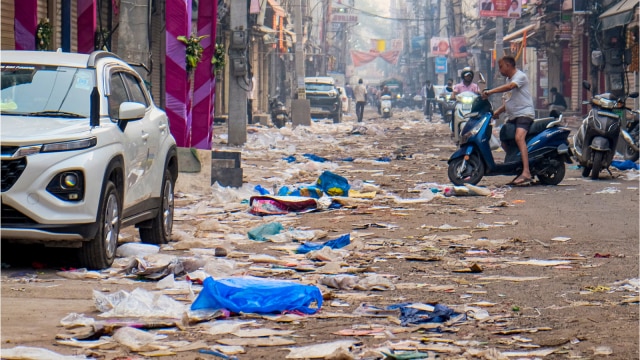Air quality in Punjab dips post-Diwali in most cities, despite yearly improvement
Although the average AQI for Punjab after Diwali night this year was 206, it was still lower than the average of 255 recorded last year and 268 in 2021.
 A street covered with burst firecrackers and confetti, a day after the 'Diwali' festival, in Gurugram. (Representative Photo)
A street covered with burst firecrackers and confetti, a day after the 'Diwali' festival, in Gurugram. (Representative Photo)Punjab witnessed mixed trends in air quality this Diwali, with some cities showing improvement compared to previous years, while others recorded alarming spikes in pollution levels. On Diwali day, most cities across the state recorded moderate air quality. However, by Diwali night and the following day, the Air Quality Index (AQI) rose sharply in several regions, reflecting the impact of firecracker use during celebrations.
Ludhiana, for instance, recorded an AQI of 139 on Diwali day, which rose to 281 after Diwali night. Mandi Gobindgarh saw a jump from 207 to 293, while Patiala’s AQI increased from 104 to 211. Roopnagar went from 89 to 122, Amritsar from 132 to 227, and Jalandhar from 196 to 247.
Khanna recorded a smaller rise from 125 to 138. Interestingly, Bathinda was one of the few cities where AQI dropped after Diwali, going from 204 on Diwali day to 133 the next day. This trend was not common, as most other cities reported deterioration in air quality after the festival night.
Although the average AQI for Punjab after Diwali night this year was 206, it was still lower than the average of 255 recorded last year and 268 in 2021. This marks a 19.2 per cent improvement compared to 2024 and a significant 23.1 per cent improvement compared to 2021.
For brief periods during Diwali night, air quality in several cities spiked to extremely hazardous levels. In certain areas of Roopnagar, Jalandhar, and Amritsar, the AQI even touched the maximum measurable level of 500.
Parts of Ludhiana recorded AQI peaks of 438, while in Patiala, the index surged to 486 around midnight. These short-lived but severe spikes suggest that more intense firecracker activity took place in these areas during peak celebration hours.
According to the Punjab Pollution Control Board, an AQI between zero and 50 is considered good, 51 to 100 satisfactory, 101 to 200 moderate, 201 to 300 poor, 301 to 400 very poor, 401 to 500 severe, and severe plus.
A large number of people are celebrating Diwali on Tuesday in Punjab, and because of this, the air quality may worsen further, and it may continue for several days as people keep on bursting crackers even after the Diwali festival for a couple of days.
Also, in Punjab, the paddy harvesting season is at its peak now, and wheat sowing will start from the coming week, and farmers may burn stubble to clear the fields. As of Diwali night, only 45 farm fires were recorded.







